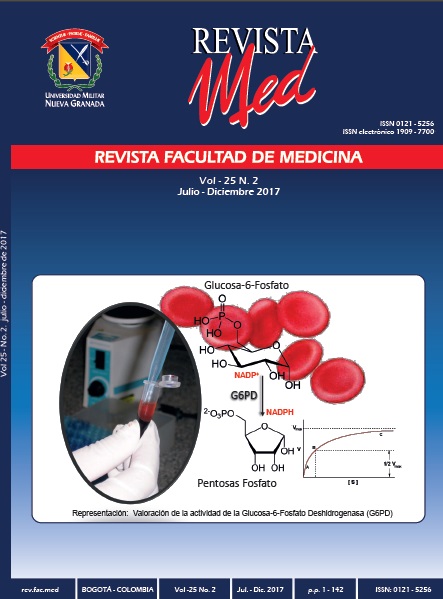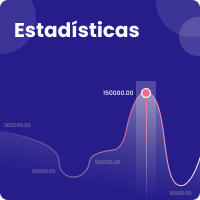Diarrea pos colecistectomía, enfoque diagnóstico y terapéutico
Resumen
La colelitiasis es una enfermedad muy prevalente en la población general. El tratamiento de la colelitiasis, cuando se torna sintomática, es fundamentalmente quirúrgico. Una de sus complicaciones es la diarrea pos-colecistectomía que se define como la presencia de 3 o más deposiciones diarreicas por día por más de cuatro semanas en pacientes con el antecedente de colecistectomía, en ausencia de otra causa que explique la sintomatología. Debido a la incidencia reportada en la literatura alrededor del 15%, esta revisión presenta la epidemiologia, fisiopatología, diagnóstico, clasificación y tratamiento de esta patología. Adicionalmente se plantea una nueva clasificación de la patología que se correlacione con la fisiopatología.
Descargas
Lenguajes:
esReferencias bibliográficas
Shaffer EA. Epidemiology of gallbladder stone disease. Best Pract Res Clin Gastroenterol. 2006;20(6):981-96. https://doi.org/10.1016/j.bpg.2006.05.004
Shaffer EA. Epidemiology and risk factors for gallstone disease: has the paradigm changed in the 21st century? Curr Gastroenterol Rep. mayo de 2005;7(2):132-40.
Everhart JE, Ruhl CE. Burden of Digestive Diseases in the United States Part I: Overall and Upper Gastrointestinal Diseases. Gastroenterology. febrero de 2009;136(2):376-86.
León-Barúa R. Diarrea crónica postcolecistectomía. Rev Gastroenterol Perú. enero de 2013;33(1):82-4.
Stinton LM, Myers RP, Shaffer EA. Epidemiology of Gallstones. Gastroenterol Clin North Am. junio de 2010;39(2):157-69.
Sherlock S. Diseases of the liver and biliary system. 4.a ed. Oxford: Blackwell Science; 1968.
Fort JM, Azpiroz F, Casellas F, Andreu J, Malagelada JR. Bowel habit after cholecystectomy: physiological changes and clinical implications. Gastroenterology. septiembre de 1996;111(3):617-22.
Fisher M, Spilias DC, Tong LK. Diarrhoea After Laparoscopic Cholecystectomy: Incidence and Main Determinants. ANZ J Surg. 1 de junio de 2008;78(6):482-6.
Alemi F, Poole DP, Chiu J, Schoonjans K, Cattaruzza F, Grider JR, et al. The Receptor TGR5 Mediates the Prokinetic Actions of Intestinal Bile Acids and Is Required for Normal Defecation in Mice. Gastroenterology. Enero de 2013;144(1):145-54.
Hofmann AF, Small DM. Detergent properties of bile salts: correlation with physiological function. Annu Rev Med. 1967;18:333-76. https://doi.org/10.1146/annurev.me.18.020167.002001
Barkun AN, Love J, Gould M, Pluta H, Steinhart H. Bile acid malabsorption in chronic diarrhea: pathophysiology and treatment. Can J Gastroenterol J Can Gastroenterol. noviembre de 2013;27(11):653-9.
Ridlon JM, Kang D-J, Hylemon PB. Bile salt biotransformations by human intestinal bacteria. J Lipid Res. 1 de febrero de 2006;47(2):241-59.
Sayin SI, Wahlström A, Felin J, Jäntti S, Marschall H-U, Bamberg K, et al. Gut microbiota regulates bile acid metabolism by reducing the levels of tauro-beta-muricholic acid, a naturally occurring FXR antagonist. Cell Metab. 5 de febrero de 2013;17(2):225-35.
Shin A, Camilleri M, Vijayvargiya P, Busciglio I, Burton D, Ryks M, et al. Bowel functions, fecal unconjugated primary and secondary bile acids, and colonic transit in patients with irritable bowel syndrome. Clin Gastroenterol Hepatol Off Clin Pract J Am Gastroenterol Assoc. octubre de 2013;11(10):1270-1275.e1.
Small DM, Dowling RH, Redinger RN. The enterohepatic circulation of bile salts. Arch Intern Med. octubre de 1972;130(4):552-73.
Hofmann AF. The syndrome of ileal disease and the broken enterohepatic circulation: cholerheic enteropathy. Gastroenterology. abril de 1967;52(4):752-7.
Camilleri M. Bile Acid diarrhea: prevalence, pathogenesis, and therapy. Gut Liver. 23 de mayo de 2015;9(3):332-9.
Out C, Groen AK, Brufau G. Bile acid sequestrants: more than simple resins. Curr Opin Lipidol. febrero de 2012;23(1):43-55.
Lu TT, Makishima M, Repa JJ, Schoonjans K, Kerr TA, Auwerx J, et al. Molecular Basis for Feedback Regulation of Bile Acid Synthesis by Nuclear Receptors. Mol Cell. septiembre de 2000;6(3):507-15.
Zweers SJLB, Booij KAC, Komuta M, Roskams T, Gouma DJ, Jansen PLM, et al. The human gallbladder secretes fibroblast growth factor 19 into bile: Towards defining the role of fibroblast growth factor 19 in the enterobiliary tract. Hepatology. 1 de febrero de 2012;55(2):575-83.
Walters JRF, Tasleem AM, Omer OS, Brydon WG, Dew T, le Roux CW. A New Mechanism for Bile Acid Diarrhea: Defective Feedback Inhibition of Bile Acid Biosynthesis. Clin Gastroenterol Hepatol. noviembre de 2009;7(11):1189-94.
Wong BS, Camilleri M, Carlson P, McKinzie S, Busciglio I, Bondar O, et al. Increased bile acid biosynthesis is associated with irritable bowel syndrome with diarrhea. Clin Gastroenterol Hepatol Off Clin Pract J Am Gastroenterol Assoc. septiembre de 2012;10(9):1009-1015.e3.
Borghede MK, Schlütter JM, Agnholt JS, Christensen LA, Gormsen LC, Dahlerup JF. Bile acid malabsorption investigated by selenium-75-homocholic acid taurine ((75)SeHCAT) scans: causes and treatment responses to cholestyramine in 298 patients with chronic watery diarrhoea. Eur J Intern Med. diciembre de 2011;22(6):e137-140.
McJunkin B, Fromm H, Sarva RP, Amin P. Factors in the mechanism of diarrhea in bile acid malabsorption: Fecal pH—A key determinant. Gastroenterology. 1 de junio de 1981;80(6):1454-64.
Walters JRF, Appleby RN. Editorial: colesevelam effects on faecal bile acids in IBS with diarrhoea. Aliment Pharmacol Ther. Abril de 2015;41(7):696-7.
Schiller LR, Pardi DS, Spiller R, Semrad CE, Surawicz CM, Giannella RA, et al. Gastro 2013 APDW/WCOG Shanghai working party report: chronic diarrhea: definition, classification, diagnosis. J Gastroenterol Hepatol. enero de 2014;29(1):6-25.
Corazziari ES. Pathophysiological approach to chronic diarrhoea. Intern Emerg Med. octubre de 2012;7 Suppl 3:S251-254.
Schiller LR. Definitions, pathophysiology, and evaluation of chronic diarrhoea. Best Pract Res Clin Gastroenterol. octubre de 2012;26(5):551-62.
Steffer KJ, Santa Ana CA, Cole JA, Fordtran JS. The practical value of comprehensive stool analysis in detecting the cause of idiopathic chronic diarrhea. Gastroenterol Clin North Am. septiembre de 2012;41(3):539-60.
Vijayvargiya P, Camilleri M, Shin A, Saenger A. Methods for diagnosis of bile acid malabsorption in clinical practice. Clin Gastroenterol Hepatol Off Clin Pract J Am Gastroenterol Assoc. octubre de 2013;11(10):1232-9.
Fromm H, Hofmann AF. Breath test for altered bile-acid metabolism. Lancet Lond Engl. 18 de septiembre de 1971;2(7725):621-5.
Merrick MV, Eastwood MA, Anderson JR, Ross HM. Enterohepatic circulation in man of a gamma-emitting bile-acid conjugate, 23-selena-25-homotaurocholic acid (SeHCAT). J Nucl Med Off Publ Soc Nucl Med. febrero de 1982;23(2):126-30.
Gracie DJ, Kane JS, Mumtaz S, Scarsbrook AF, Chowdhury FU, Ford AC. Prevalence of, and predictors of, bile acid malabsorption in outpatients with chronic diarrhea. Neurogastroenterol Motil Off J Eur Gastrointest Motil Soc. noviembre de 2012;24(11):983-e538.
Shivaji UN, Chowdhury FU, Ford AC. Letter: bile acid diarrhoea is not a rare cause of diarrhoea in secondary care. Aliment Pharmacol Ther. julio de 2014;40(2):216.
Riemsma R, Al M, Corro Ramos I, Deshpande SN, Armstrong N, Lee Y-C, et al. SeHCAT [tauroselcholic (selenium-75) acid] for the investigation of bile acid malabsorption and measurement of bile acid pool loss: a systematic review and cost-effectiveness analysis. Health Technol Assess Winch Engl. diciembre de 2013;17(61):1-236.
Sauter GH, Münzing W, von Ritter C, Paumgartner G. Bile acid malabsorption as a cause of chronic diarrhea: diagnostic value of 7alpha-hydroxy-4-cholesten-3-one in serum. Dig Dis Sci. enero de 1999;44(1):14-9.
Gälman C, Arvidsson I, Angelin B, Rudling M. Monitoring hepatic cholesterol 7alpha-hydroxylase activity by assay of the stable bile acid intermediate 7alpha-hydroxy-4-cholesten-3-one in peripheral blood. J Lipid Res. abril de 2003;44(4):859-66.
Pattni SS, Brydon WG, Dew T, Johnston IM, Nolan JD, Srinivas M, et al. Fibroblast growth factor 19 in patients with bile acid diarrhoea: a prospective comparison of FGF19 serum assay and SeHCAT retention. Aliment Pharmacol Ther. octubre de 2013;38(8):967-76.
Koga T, Nishida T, Miwa H, Yamamoto M, Kaku K, Yao T, et al. Effects of dietary butter fat on fecal bile acid excretion in patients with Crohn's disease on elemental diet. Dig Dis Sci. noviembre de 1984;29(11):994-9.
Westergaard H. Bile Acid malabsorption. Curr Treat Options Gastroenterol. febrero de 2007;10(1):28-33.
Herrema H, Meissner M, van Dijk TH, Brufau G, Boverhof R, Oosterveer MH, et al. Bile salt sequestration induces hepatic de novo lipogenesis through farnesoid X receptor- and liver X receptor alpha-controlled metabolic pathways in mice. Hepatol Baltim Md. marzo de 2010;51(3):806-16.
Garbutt JT, Kenney TJ. Effect of cholestyramine on bile acid metabolism in normal man. J Clin Invest. 1 de noviembre de 1972;51(11):2781-9.
Halilbasic E, Claudel T, Trauner M. Bile acid transporters and regulatory nuclear receptors in the liver and beyond. J Hepatol. enero de 2013;58(1):155-68.
West RJ, Lloyd JK. The effect of cholestyramine on intestinal absorption. Gut. febrero de 1975;16(2):93-8.
Walters JRF, Pattni SS. Managing bile acid diarrhoea. Ther Adv Gastroenterol. noviembre de 2010;3(6):349-57.
Insull W. Clinical utility of bile acid sequestrants in the treatment of dyslipidemia: a scientific review. South Med J. marzo de 2006;99(3):257-73.
Wilcox C, Turner J, Green J. Systematic review: the management of chronic diarrhoea due to bile acid malabsorption. Aliment Pharmacol Ther. mayo de 2014;39(9):923-39.
Stotzer P-O, Abrahamsson H, Bajor A, Sadik R. Effect of Cholestyramine on Gastrointestinal Transit in Patients with Idiopathic Bile Acid Diarrhea: A Prospective, Open-Label Study. Neuroenterology. 2013;2:1-5. https://doi.org/10.4303/ne/235657
Bajor A, Törnblom H, Rudling M, Ung K-A, Simrén M. Increased colonic bile acid exposure: a relevant factor for symptoms and treatment in IBS. Gut. enero de 2015;64(1):84-92.
Arnold MA, Swanson BJ, Crowder CD, Frankel WL, Lam-Himlin D, Singhi AD, et al. Colesevelam and colestipol: novel medication resins in the gastrointestinal tract. Am J Surg Pathol. noviembre de 2014;38(11):1530-7.
Wedlake L, Thomas K, Lalji A, Anagnostopoulos C, Andreyev HJN. Effectiveness and tolerability of colesevelam hydrochloride for bile-acid malabsorption in patients with cancer: a retrospective chart review and patient questionnaire. Clin Ther. noviembre de 2009;31(11):2549-58.
Smith MJ, Cherian P, Raju GS, Dawson BF, Mahon S, Bardhan KD. Bile acid malabsorption in persistent diarrhoea. J R Coll Physicians Lond. octubre de 2000;34(5):448-51.
Zhang JH, Nolan JD, Kennie SL, Johnston IM, Dew T, Dixon PH, et al. Potent stimulation of fibroblast growth factor 19 expression in the human ileum by bile acids. Am J Physiol Gastrointest Liver Physiol. 15 de mayo de 2013;304(10):G940-948.
Mroz MS, Keating N, Ward JB, Sarker R, Amu S, Aviello G, et al. Farnesoid X receptor agonists attenuate colonic epithelial secretory function and prevent experimental diarrhoea in vivo. Gut. mayo de 2014;63(5):808-17.
Walters JRF, Johnston IM, Nolan JD, Vassie C, Pruzanski ME, Shapiro DA. The response of patients with bile acid diarrhoea to the farnesoid X receptor agonist obeticholic acid. Aliment Pharmacol Ther. enero de 2015;41(1):54-64.







.png)





